The “tummy tuck” or abdominoplasty is for women and men bothered by displaced abdominal muscles, loose skin, or fat deposits. Pregnancy can stretch a woman’s skin and stomach muscles, as can profound weight loss. Abdominoplasty or “tummy tuck” is the procedure of choice for these conditions. Dr. Paul Pin has extensive experience performing the tummy tuck procedure at his Dallas, TX practice.
Tummy Tuck Surgery Candidates
The best candidates for a tummy tuck are people in relatively good shape, but with excess abdominal skin and/or displaced abdominal muscles. Patients with only excess fat are advised to have liposuction, as it is simpler and less effective. Women who are considering having more children are advised to postpone the procedure as a pregnancy will reverse the benefits of a tummy tuck.
Tummy Tuck Myths
An abdominoplasty used to be the most painful and unpleasant plastic surgery procedure. Even the mention of it could cause patients to recoil! The myth is that it still is that miserable. Patients constantly fear they won’t be able to bathe normally, stand up straight, or return to work in a reasonable amount of time. Fortunately, newer techniques have made this operation much more tolerable. Here are some improvements in the procedure.
- Efficiency: Surgeons are much more efficient than in the past. There are many reasons for this, but the impact is great. A typical abdominoplasty in the 90s might take four hours or more. Now, most of mine are completed in under two hours. Speed itself does not ensure a better result, but it absolutely reduces blood loss and the risk of blood clots (DVT.)
- Better Pain Control: Anesthetics are now better able to have patients wake up smoothly without ever experiencing horrible discomfort. Additionally, many surgeons augment the general anesthetic by using local anesthesia also. Finally, PCA’s or patient controlled analgesia, allows the abdominoplasty patient to administer their own narcotic intravenously when they need it, without having to wait for a nurse. When I visit patients the next morning, most report having a very tolerable night, something that used to be rare.
- Less Morbidity: This means patients just are not put through as much misery! Plastic surgeons used to think “the tighter, the better” when it came to abdominoplasty. Due to experience with tissue expansion, surgeons learned that being excessively tight does nothing positive for the long-term result. It does cause significantly more pain, lead to wider scars and increase the risk of tissue necrosis (death.) Because the skin is no longer excessively tight, I allow my patients to stand up straight the first night. This permits patients to walk more normally and certainly prevents a lot of needless back pain!
- Simpler Wound Care: Abdominoplasties used to require suture removal and dressing changes. This is no longer the case. Many surgeons use absorbable sutures to avoid stitch marks and the misery of removing sutures. Additionally, surgical glue called Dermabond can be applied in the OR so no bandages are needed after surgery. Furthermore, this lets me have patients shower the next day so they can return to normal as soon as possible.
- Quicker Return to Normal: Since patients have less pain and are more mobile earlier, they can recover faster. Patients who work in an office setting can usually return to work in ten days and patients can begin exercising in two weeks.
In short, abdominoplasty is a much easier procedure to undergo than in the past. Despite these improvements in abdominoplasty, it remains a major surgical procedure.
The Abdominoplasty Procedure
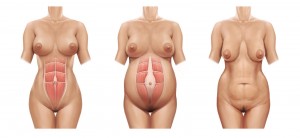
The procedure, which usually takes two hours, is done in a hospital under general anesthesia by an Anesthesiologist. In a small number of cases, there is little excess skin, so a “mini-tummy tuck” can be performed. Through a much shorter incision, the muscles can be repaired, resulting in a flatter abdomen with little scarring.
More typically, a longer incision is employed to elevate the skin from the abdominal wall up to the lower border of the ribs. This gives access to the rectus muscles that have been displaced by pregnancy. The muscles are then carefully repaired in the midline, making their contraction more effective, so the woman can have a flatter abdomen.
In the absence of a prior pregnancy, as in weight loss or in males, the muscles are non-displaced, making repair unnecessary and the procedure much simpler. The excess skin is then removed and a new umbilicus (belly button) is fashioned. The skin is stretched down and additional skin may be removed.
Some patients choose to undergo combination treatment with the tummy tuck procedure as part of a Mommy Makeover. Related procedures include liposuction, placement of breast implants, breast lift, and breast reduction.
Limited-incision, Short Scar or Mini Tummy Tuck
A traditional tummy tuck removes skin from the belly button to the pubic area, while also repairing the rectus muscles. Some patients have very little excess skin, but still have displaced muscles. These patients are candidates for a short-scar tummy tuck. In this procedure, the incision is very low and usually only slightly longer than a C section incision. The skin of the abdominal wall is lifted, including the belly button, the muscles are repaired and then skin is sutured back down. In patients that are “high waisted,” the belly button can be moved down to allow some skin removal.
While this procedure is technically difficult because the surgeon has to suture all the way to the sternum from the pubic area, the results can be great in well-chosen patients. This procedure is different than what most call a “mini-tummy tuck.” In that operation , the muscle repair is only up to the belly button, which frequently leads to bulging in the upper, unrepaired abdomen.
Less Painful Tummy Tuck with Exparel
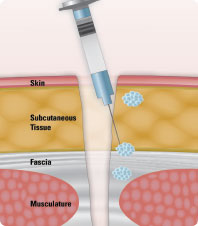 The biggest problem with an abdominoplasty or tummy tuck, has always been post-operative pain, which has been compared to that of a C- section. A new, ultra long-acting local anesthetic has reduced this pain dramatically.
The biggest problem with an abdominoplasty or tummy tuck, has always been post-operative pain, which has been compared to that of a C- section. A new, ultra long-acting local anesthetic has reduced this pain dramatically.
Traditionally, tummy tuck patients would be seen walking hunched over to reduce their pain. Narcotics that treated pain resulted in significant nausea, constipation, itching, rashes, etc. Now there is Exparel. This is an old local anesthetic called bupivacaine that is bound to a small particle, which allows controlled release of the medication for up to three days.
During a tummy tuck, the medicine is injected into the site of the muscle repair, as well as into the surrounding skin. When patients awaken from their surgery, they have considerably less pain, and thus less need for narcotics. Since the medicine is long acting, patients “miss” the most difficult part of the recovery. By the time it wears off, most of the worst pain is over. Patients can mobilize more quickly, which has the added benefit of reducing the risk of blood clots.
Thanks to Exparel, patients interested in tummy tucks no longer have to fear being in agony post-operatively.
Combining Tummy Tucks with Gynecological Surgery
Patients interested in tummy tucks commonly inquire about combining this procedure with a hysterectomy and/or surgery for female urinary incontinence. A hysterectomy may be performed in patients that have had children and have uterine problems, such as heavy flow menstrual bleeding.
Thanks to modern surgical techniques that have made gynecological procedures quicker and less invasive, it is now much safer to combine these types of procedures. If you think this is something you would be interested in, please contact my office so you can receive more information.
Tummy Tuck Before and After Photos
Featured Cases
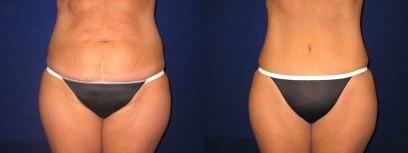
Tummy Tuck After Pregnancy
This 47 year old mother of three was dissatisfied with her abdomen. She was 5'4" and weighed 155 pounds at the time of her abdominoplasty.
+ See Full Case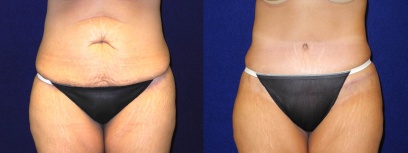
Tummy Tuck After Pregnancy
This 42-year-old mother of two wanted to improve her abdomen. She was 5'3" and weighed 140 pounds and underwent an abdominoplasty.
+ See Full Case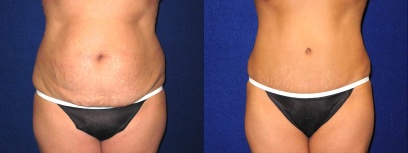
Tummy Tuck After Pregnancy
This 39-year-old woman was 5'2" and weighed 160 pounds. She had had three children and was interested in improving her abdomen, so she underwent and abdominoplasty.
+ See Full CaseTummy Tuck Recovery
All patients remain in the hospital overnight for monitoring, pain control, and to help with early ambulation to prevent blood clots. Patients are encouraged to stand up straight immediately following the procedure. All sutures are dissolvable and surgical glue is applied, so bandages are not needed and bathing is allowed the following day. Pain medication is taken for the first few days after the abdominoplasty procedure, while compression garments can be used to control bruising and swelling. Most patients can return to the office in 10 days and can resume exercise in two weeks. Complete healing takes about six weeks.
Drains vs. No Drains
When the skin is elevated off the muscle in a tummy tuck, it creates a space that can fill with fluid, call a seroma. Traditionally, rubber tubes called drains were left to evacuate this fluid. These drains are removed in the office once the fluid subsides. In recent years there has been a movement away from drains.
The advantages of no drains are:
- Nothing sticking through the skin
- Nothing that needs to be cared for or removed
The disadvantages are:
- Patients stay swollen longer
- Compression garments need to be worn longer
- Activity is restricted for a longer period after surgery
The advantages of drains are:
- Less swelling
- No compression garments required
- Able to return to exercise in two weeks
The disadvantages of drains are:
- Uncomfortable to have something through skin
- Hassle to take care of for four to five days.
Drains are something to discuss prior to surgery so the patient can have the procedure and recovery that suits them the best.
Weight Loss After Tummy Tuck
In most cases, patients are advised to be near their goal weight prior to surgery. The reason for this is to ensure that an adequate amount of skin is removed, and because a lower BMI is associated with lower surgical risk. In some cases, however, a tummy tuck procedure done before weight loss can provide patients the impetus they need to lose weight after surgery. For unknown metabolic reasons, it is frequently easier to lose weight after surgery, once the lower abdominal fat is removed. Weight loss after tummy does not diminish the result, but enhance it. Case number 1 above lost 20 pounds after surgery and looks even better than she would have without the weight loss.
Tummy Tuck Side Effects
- After tummy tuck surgery, patients experience the following side effects:
- Discomfort
- Bruising
- Swelling
- Itching around the incision site
- Numbness
Tummy Tuck Risks
- The risks associated with tummy tuck surgery include:
- Infection
- Allergic reaction to anesthesia
- Bleeding
- Accumulation of fluid
- Delayed wound healing
- Formation of blood clots
- Permanent numbness
Tummy Tuck Results
Many of Dr. Pin’s patients have successfully undergone the tummy tuck procedure. A flatter, trimmer abdomen can make you more comfortable with yourself and confident with others. Although tummy tuck produces excellent results, it does result in scarring. The tummy tuck scars are located in the bikini area, so they usually remain hidden when you are wearing a bathing suit or underwear. The length of the incision depends on the amount of skin removal that is required. Generally, tummy tuck incisions heal quite well, and the resulting scars fade significantly in the year after surgery. About a year after surgery, the final scarring will be visible.
To schedule your tummy tuck consultation, contact our practice today.
